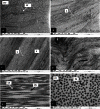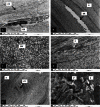Keratoconus corneal architecture after riboflavin/ultraviolet A cross-linking: ultrastructural studies
- PMID: 23878503
- PMCID: PMC3716411
Keratoconus corneal architecture after riboflavin/ultraviolet A cross-linking: ultrastructural studies
Abstract
Purpose: Study to investigate the effects of collagen cross-linking on the ultrastructural organization of the corneal stroma in the human keratoconus cornea (KC).
Methods: Three normal, three keratoconus (KC1, KC2, KC3), and three cross-linked keratoconus (CXL1, CXL2, CXL3) corneas were analyzed. The KC corneas were treated with a riboflavin-ultraviolet A (UVA) treatment (CXL) method described by Wollensak et al. Penetrating keratoplasty (PKP) was performed 6 months after treatment. All samples were processed for electron microscopy.
Results: The riboflavin-UVA-treated CXL corneal stroma showed interlacing lamellae in the anterior stroma followed by well-organized parallel running lamellae. The lamellae contained uniformly distributed collagen fibrils (CFs) decorated with normal proteoglycans (PGs). The CF diameter and interfibrillar spacing in the CXL cornea were significantly increased compared to those in the KC cornea. The PG area in the CXL corneas were significantly smaller than the PGs in the KC cornea. The epithelium and Bowman's layer were also normal. On rare occasions, a thick basement membrane and collagenous pannus were also observed.
Conclusions: Corneal cross-linking leads to modifications of the cornea stroma. The KC corneal structure showed a modification in the CF diameter, interfibrillar spacing, and PG area. This resulted in a more uniform distribution of collagen fibrils, a key feature for corneal transparency.
Figures






References
-
- Rabinowitz YS. Keratoconus. Surv Ophthalmol. 1998;42:297–319. - PubMed
-
- Tuft SJ, Moodaley LC, Gregory WM, Davison CR, Buckley RJ. Prognostic factors for the progression of keratoconus. Ophthalmology. 1994;101:439–47. - PubMed
-
- Kennedy RH, Bourne WM, Dyer JA. A 48-year clinical and epidemiologic study of keratoconus. Am J Ophthalmol. 1986;101:267–73. - PubMed
-
- Wollensak G, Spoerl E, Seiler T. Riboflavin/ultraviolet-a-induced collagen crosslinking for the treatment of keratoconus. Am J Ophthalmol. 2003;135:620–7. - PubMed
-
- Caporossi A, Mazzotta C, Baiocchi S, Caporossi T. Long-term results of riboflavin ultraviolet a corneal collagen cross-linking for keratoconus in Italy: the Siena eye cross study. Am J Ophthalmol. 2010;149:585–93. - PubMed
Publication types
MeSH terms
Substances
LinkOut - more resources
Full Text Sources
